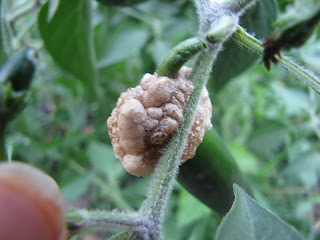 |
| These ears have a luminescence that is hard to capture. |
 |
| They look like candy! |
 |
| Black Icicle, San Marzano, and Costoluto Genovese tomatoes; Bullnose bell pepper, tomatillos, 'Carl's Glass Gem' corn, and three different types of dried beans. |
 |
| First dried beans of the season. Brockton Horticultural beans. Many, many more bean plants will be planted next year. |
 |
| Male praying mantis. |
 |
| Female praying mantis. |
"There are praying mantises in your garden?" he asked.
"Yes, three that we're aware of!" I replied. "We respect them and try our best not to disturb them too much. We want them around and we'd like it if they created eggs in our yard again this year."
"They lay eggs? How big are they?"
"Well, they don't lay eggs but they do create them somehow. They're about the size of a walnut."
"No kidding?!"
I went on to tell my Dad what the eggs look like and how I imagine the eggs are created. Something similar to how bees create hives or hornets create their nests. Maybe saliva forms the "egg" and then eggs are laid in the protective egg? The conversation peaked my curiosity; I wanted to learn how female mantids create their eggs. Two days later, I learned the answer.
This is what a praying mantis egg looks like. Sort of like hardened foam, or a large nugget of puffed wheat.
 |
See, I wasn't paying attention. I should have realized that the conversation with my Father was more than just that. It was also an omen since I would soon learn first-hand how those amazing insects create their eggs.
While picking serrano peppers to add to a gift basket for a dear friend's birthday, I was focused on peppers and completely overlooked a six-inch long praying mantis that was right in front of me creating life. I reached up to pick a pepper and, mostly focused on the pepper, spotted the tiny egg. *snip* The pepper came away from the branch it was attached to and, now in my hand, I moved it to my left to drop it into the basket next to me. In the second it took to make that movement, it registered in my brain that the egg was that of a praying mantis and that a strand of a thick, foamy substance was trailing off the end of the pepper. Wait! No! That egg is fresh! Ohmygoshohmygoshohmygosh! I'm SO sorry! Mama mantid was on the ground in front of me. She actually traveled on the top of the hand that grasped the freshly cut pepper.
Concerned that I may have cut her or, worse, clipped a limb off, I lifted her with a twig and gave her a quick once over while placing her back on the serrano bush near the egg she was forming. Gosh, I felt so incredibly bad for disturbing her. I hoped that my actions and lack of observation didn't hurt her or would cause her not to continue creating new life.
Saturday afternoon, I headed out to the garden to inspect the serrano bush and happily discovered that a second egg is on another branch not too far from the first!
The eggs, or ootheca, are created from the back of the abdomen. A substance similar to a foamy meringue is excreted from the rear of the abdomen, while the eggs are simultaneously deposited within it. The ootheca hardens and protects the eggs until they hatch the following year in early summer. The ootheca can contain anywhere from one dozen to 400 eggs.
A couple cool facts about praying mantis': they can turn their heads 180 degrees. The only insect that's able to turn their head on an axis. Mantids also have a single ear that has two eardrums which is located on their abdomen, just above their rear legs. Their ear allows them to hear ultrasound so while in flight they can avoid being eaten by bats.
For more interesting praying mantis facts, visit these two web sites:
http://www.theprayingmantis.org/Home.php
http://deadlymantis.com/Deadlymantis.com/Praying_Mantis.html
Happy harvesting!



